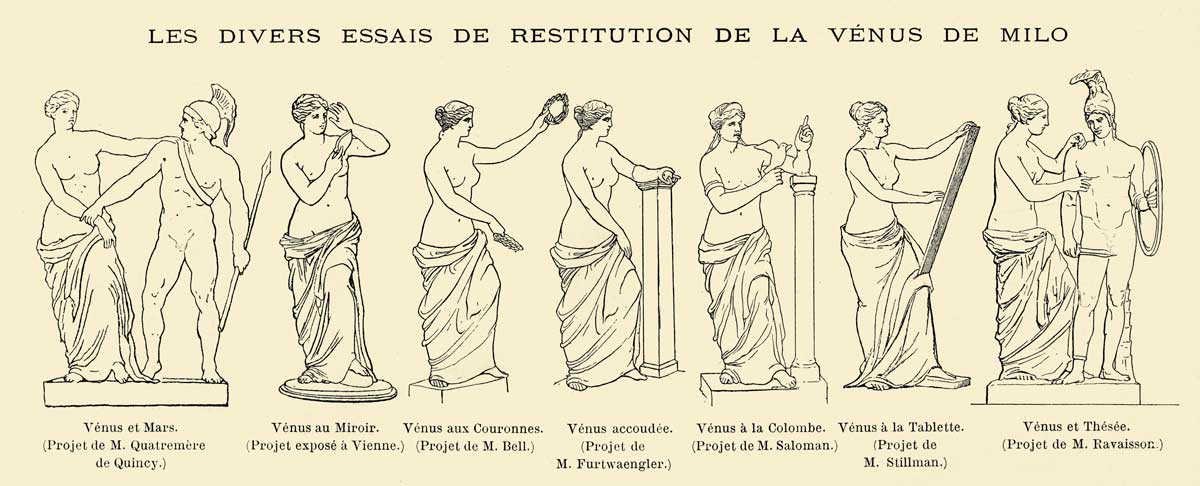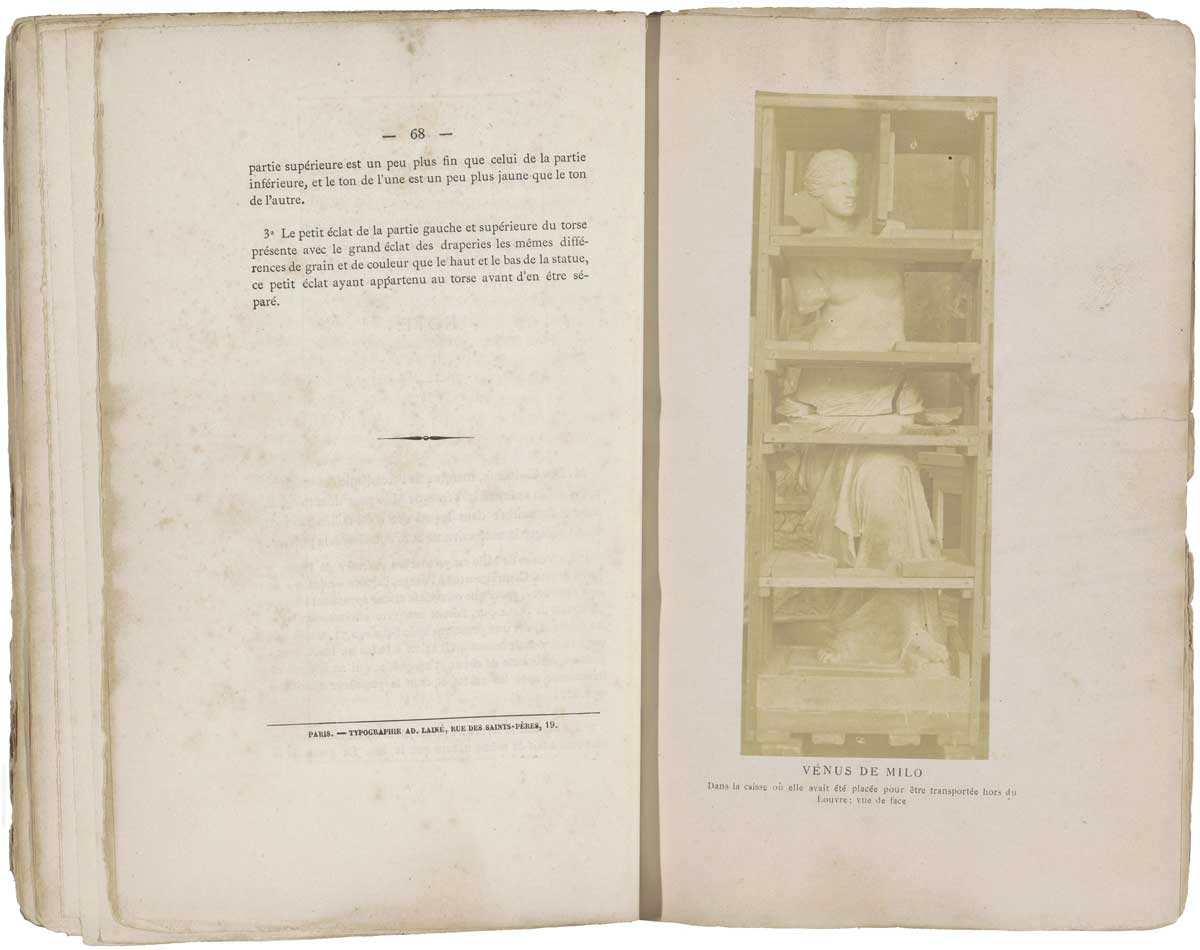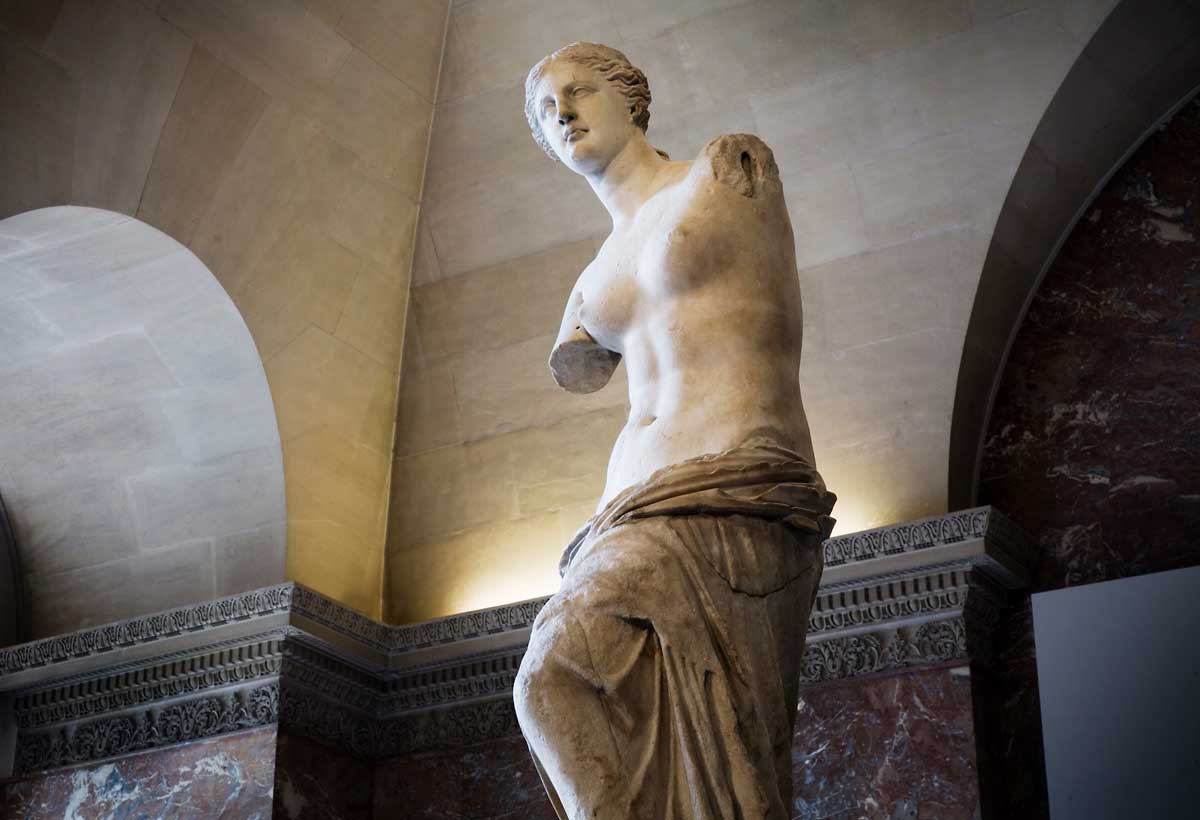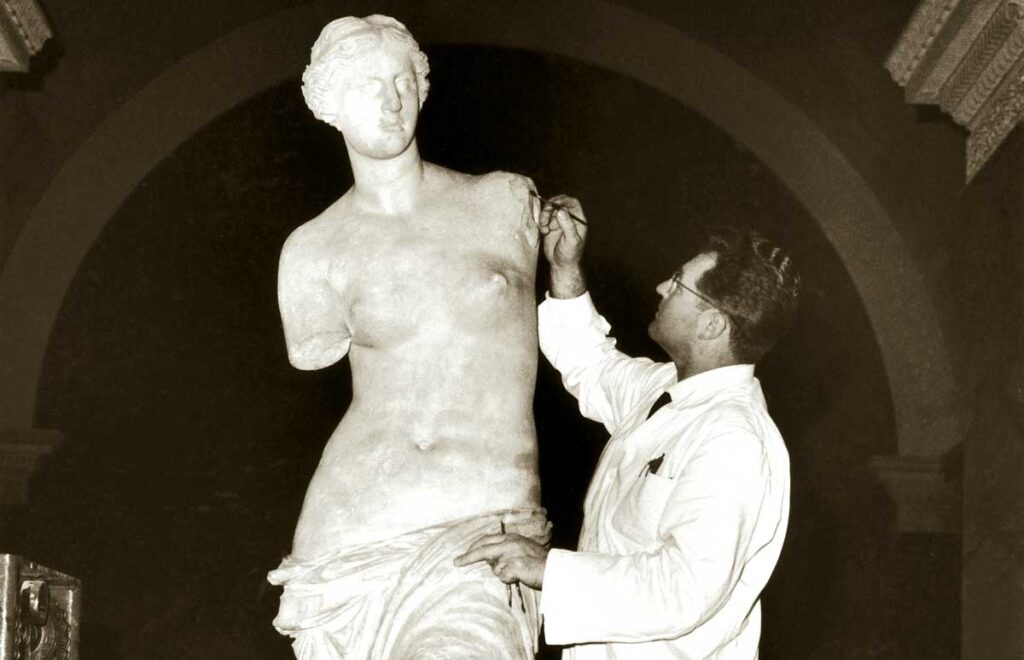[ad_1]
On 8 April 1820, Olivier Voutier was digging on the Greek island of Milos (or Melos) when he noticed something extraordinary. A 23-year-old ensign in the French Navy, he had a passion for archeology and had come that morning to explore the ruins of a theatre. He had already made some interesting discoveries, but then something caught his eye. A farmer named Yorgos Kentrotas was pricing stones from a nearby wall. After stopping suddenly, he was now gazing intently into an ancient niche he had uncovered. While walking past where the farmer was standing, Voutier was amazed to see a statue sticking out of the earth. He persuades the farmer to dig it up and soon finds himself standing in front of a marble bust. He was missing some hair, had a huge gap in his arm and had scratches and bumps all over. Still, he could see that it was extraordinary.
Voutier and Kentrotus soon uncovered the bottom half, which was buried under the niche, with part missing from the bottom. With some difficulty, he put all three pieces together and stood back to admire his find. The idol was of a woman, naked from the waist up, with her legs covered by a loose-fitting cloth. She was turning slightly to the left, her head was on one side and there was a look of anguish in her eyes. But where were his hands? Although some later writers claimed that the statue was still attached, a sketch Voutier made that afternoon showed that both were missing. When Kentrotus looked around a little more, he saw two hermes (square pillars with carved heads on top), a hand and an apple in one hand. But there was still no clue as to how these pieces got on the statue – and there was no trace of the other arm.
the crisis of archeology
How the Venus de Milo ended up in France is unclear. Some accounts claim that it was pulled up by French sailors after a fight with Turkish marines on the beach. Others say that the Cantrotas and the island’s authorities were all set to sell.
Either way, the statue caused a sensation when it arrived in Paris. Yet it had not yet been delivered to the Louvre before difficulties began. In the early 19th century there was a practice of ‘restoring’ the idols before they were displayed. To do this, you need to have some idea of how they originally looked. But in this case, it was easier said than done. If the experts at the Louvre were to stand any In order to establish what the missing hand was doing, they first had to determine who the statue belonged to, when it was carved, and whether it had been reworked in ancient times.
Unfortunately for them there was no straight answer. Voutier assumed that the statue was of Venus and that the fruit in her hand was the apple of discord. But not everyone agreed. Some, suspecting that the hand had come from another use, thought it was a statue of victory; the other, the nymph Melos. It was the same story when it came to dating discovery. Most were convinced that it belonged to the classical period of Greek art (c.450–333 BC). One scholar even attributed it to Phidias himself. But again there were doubts. During its journey from Melos to Paris, the statue was badly damaged. Three more large pieces were broken from the hip. Restorers at the Louvre glued him back together with plaster and a few pieces of wood – not noticing that the statue now looks slightly different. To make matters worse, the grounds of a Hermès had also been torn apart. Remarkably, the piece seemed to fit neatly into the gap in the base of the statue, giving the impression that it was part of the same work. What made it so important was an inscription indicating that it was ‘[Alex]son of Andros Menides, a citizen of Antioch. Since Antioch was founded around 300 BC, this suggested that the statue was not of the classical period, but of the Hellenistic (c.333–30 BC), whose art was then considered inferior.
The confusion exposed a weakness at the heart of archaeology. Still in its infancy, it lacked an important methodology. Although most scholars were formally learned, they knew when they were piecing together the fragmentary works that they had their own preconceived notions of what ancient Greek art ‘should be’ – which meant that they had ‘Reconstruction’ was a bit better than guessing.

The most notable example comes from Antoine-Chrysostom Quatrémère de Quincy. Believing that the statue was of Venus, he speculated that she originally appeared with the god Mars and her arms were outstretched, as if to prevent her from leaving. They argued, broke up when the two parted ways after some time. The hand holding the apple, the arm piece and the inscribed base must have been later Hellenistic additions that could be safely dismissed.
There was no real evidence for most of these. It was a hump, and a bizarre one at that. But that’s the way archeology worked and no one saw any reason to disagree.
slacker comes
The revolution in archaeological thinking was not long in coming. The unlikely hero behind this was Jean-Gaspard-Félix Ravison. A dreamer, aloof scholar, he was quite spectacularly boring. Whenever he lectured, his audience would fall asleep or leave within minutes. He might never have had any effect on archeology – or the mystery of the arms of the Venus de Milo – but for a fortuitous accident.
A few weeks before the start of the Franco-Prussian War in June 1870, Rawson was appointed as the new custodian of the Louvre’s antiquities. Fearing that the advancing Prussians might loot the museum, he packed the Venus de Milo in a crate and hid it in the basement of a nearby police building. When it was finally returned to the Louvre after the war ended, however, it was found that the plaster holding the statue together had cracked in the moist air. This gave Ravison a unique opportunity to examine Venus from the inside, at which point he realized what a mess earlier restorers had made. The two main sections were joined together in such a way that the fuselage was unnaturally tilted to the right. Worse, to hide the mysterious disappearance of the engraved base, the whole thing was installed on a new base, which made it list even more. This gave a deceptive impression of both the pose of the statue and the position of its arms.

Once Ravson restored the statue’s correct posture, he could begin to wonder where the missing limbs actually went. But, like Quatremere de Quincy, he was convinced that Venus was one of a pair. Without a shred of evidence, he went on to identify the ‘missing’ figure with another statue in the Louvre’s collection, known as the Borghese Mars – which he later believed to actually be a statue of Theseus . He created his own sculptures to show how they might fit together. In the most satisfactory of these, Venus is half turned towards Theseus. His left hand, holding an apple, rests on his right shoulder; On the right, she reaches out to touch his chest.
‘scientific’ twist
This was a turning point. For all his flights of fancy, Ravison was still vaguely aware that, if archaeologists were to uncover the mystery of the Venus de Milo’s arms, they would have to start by looking at the statue itself. This was an important insight. From that point on, archeology would be dominated by a new and more self-consciously ‘scientific’ approach and evidence, rather than gut feeling, would be king.
But there was still a problem. Given that the remains of the ancient past were often fragmentary and confusing, how should one go about filling in the gaps in pieces such as the Venus de Milo? should you try to weld all Evidence available in a single, coherent picture? Or should you be more selective?
Two figures rose above this debate: Adolf Furtwängler and Salomon Reinach. Furtwängler was the embodiment of the ‘holistic’ approach. Blessed with a formidable memory, he was a genius at finding patterns amidst chaos. He made a career out of cataloging the pottery found by Heinrich Schliemann at Mycenae. By slowly and methodically sorting through thousands of pieces he was able to discern subtle variations in shape and ornamentation – and eventually assembled a complete chronology for the development of Mycenaean pottery. He later applied this technique to art. in Meisterwerke der Grichischen Plastics (1893), he was able not only to identify lost masterpieces of Greek sculpture from later Roman copies, but also to draw up a timeline of the contributions made by individual artists.
This inspired his approach to the arms of the Venus de Milo. As comprehensive as ever, Furtwängler refused to dismiss anything he found with the statue. He accepted that there was an apple in the left hand, that the idol stood alone and that the inscribed base (which had somehow disappeared) belonged to him. As such, he identified the Venus as a Hellenistic work and suggested that it originally stood beside a square column. The left hand was resting on the floor, palm facing up, while the right hand was gracefully reached towards the left thigh.

Reinach thought otherwise. Granted, he wasn’t above making a few mistakes now and then. But he had a sharp analytical eye and excelled at sifting through layers of evidence. Never was this truer than with the Venus de Milo. He believed that Furtwängler’s overall approach was not critical enough. It was like trying to do a jigsaw puzzle with too many pieces: although, with a little effort, you might be able to fit them all together, you needed the right ones to get the real picture.
Reinach was convinced that the lost inscribed base could not belong to the statue. At first, he was going over the details of Voutier’s discovery; But when the base turned a corner of the Louvre and fitted perfectly with Herm, it became clear that he was right. As to the date, he was uncertain. With evidence of a Hellenistic dating now discarded, he was tempted to relegate it to the classical period – but after comparing it with others that had recently turned up on Melos, he was less certain. . Yet his most dazzling insight pertained to weapons. Rather than propose a speculative reconstruction, or claim to have all the answers, he candidly admitted that – given the lack of evidence – they were a mystery.
not knowing
Many of Reinach’s views were broad, but this last one was correct. Unlike those before him, he accepted that uncertainty was the only valid conclusion as far as the presence of the Venus de Milo was concerned. This marked the coming of age of archaeology. It made clear that what separates scholarship from conjecture or exhaustive cataloging is the recognition that evidence has limits—and that, sometimes, puzzles cannot be solved adequately.
Barring any new discoveries, we will never know what Venus de Milo really looked like. And maybe that’s not a bad thing. Far from discouraging, its incompleteness adds to its mystery and appeal. It forces viewers not only to imagine what could have been, but also to interrogate how we view the ancient past. Hands-off fun, you might say.
Alexander Lee is a fellow at the Center for Renaissance Studies at the University of Warwick. His latest book, Machiavelli: His Life and TimesNow available in paperback.
[ad_2]



